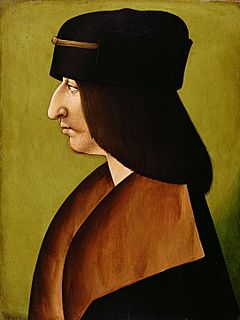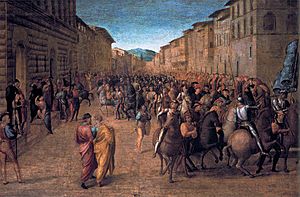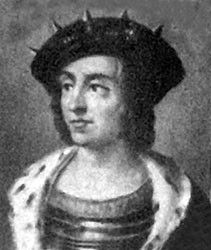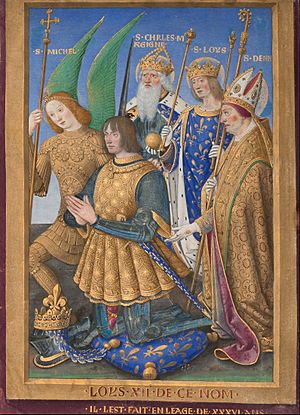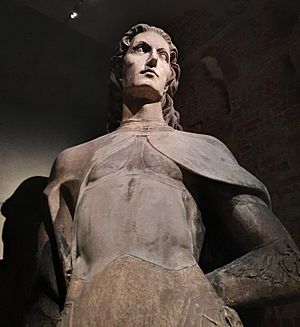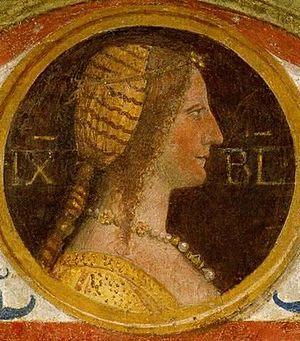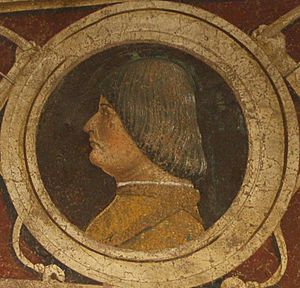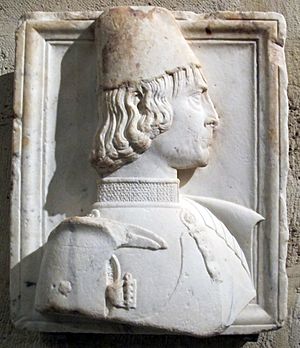Italian War of 1494–1495 facts for kids
Quick facts for kids First Italian War |
|||||||
|---|---|---|---|---|---|---|---|
| Part of the Italian Wars | |||||||
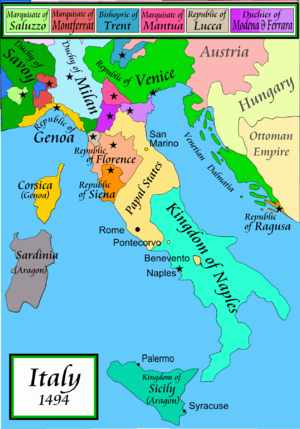 Italy in 1494 |
|||||||
|
|||||||
| Belligerents | |||||||
|
|
1494: 1495: League of Venice
|
||||||
| Commanders and leaders | |||||||
|
|
|
||||||
| Strength | |||||||
| Unknown | |||||||
| Casualties and losses | |||||||
| 13,000 men | Unknown | ||||||
The First Italian War, also called the Italian War of 1494 or Charles VIII's Italian War, was the first part of the Italian Wars. In this war, Charles VIII of France fought against the Holy Roman Empire, Spain, and a group of Italian states. This group was led by Pope Alexander VI and was known as the League of Venice. Charles VIII initially had help from the Duchy of Milan.
Contents
Key Events of the War
This is a quick look at important events and battles during the war.
- 25 January 1494: King Ferdinand I of Naples died. His son Alfonso II of Naples took over. King Charles VIII of France believed he should be the king of Naples. He started getting ready to invade Italy.
- 5–8 September 1494: Battle of Rapallo. The French navy won a land battle. The Neapolitans left Rapallo, and the French army looted the town.
- 11 September 1494: French King Charles VIII and Louis of Orléans arrived in Asti. They made an alliance with Duke Ludovico Sforza and Beatrice d'Este.
- 17 October 1494: Small fights happened near Sant'Agata sul Santerno. The Neapolitans won these small battles.
- 19–21 October 1494: Siege of Mordano. The French and Milanese won. French soldiers looted Mordano.
- 26–29 October 1494: Siege of Fivizzano. The French won and looted the town.
- 8–9 November 1494: A revolt in Florence against the de' Medici family. The Florentine people won. Piero the Unfortunate was removed from power. The Republic of Florence was brought back, led by Girolamo Savonarola.
- Mid-November – 28 November 1494: The French occupied Florence. A revolt or looting was avoided. Charles VIII then marched towards Rome.
- 31 December 1494 – 6 January 1495: The French entered Rome peacefully with Pope Alexander VI's permission. However, some French soldiers still looted.
- ? 1495: The French conquered and destroyed the Castello di Monte San Giovanni Campano. The French won.
- ? 1495: The French looted Tuscania (Province of Viterbo). The French won.
- 22 February 1495: The French army captured Naples without a fight. Ferdinand II of Naples fled to Sicily but continued fighting. Charles VIII became king of Naples. He made Gilbert, Count of Montpensier his representative.
- 31 March 1495: Several Italian states (Naples, Venice, Florence, Milan, Papal States, Genoa, Mantua), Spain, and the Holy Roman Empire formed the League of Venice. Their goal was to force the French army out of Italy. Milan switched sides and joined the League of Venice.
- 2 May 1495: Battle of Rapallo (1495). The League of Venice won. The Genoese navy defeated the French navy. This made the French garrison in Rapallo surrender. The French lost much of their war supplies.
- 30 May 1495: Charles split his army. He left half in Naples and took the other half to march back to France.
- 11 June 1495: Louis of Orléans took over Novara.
- 28 June 1495: Battle of Seminara. The French won a tactical victory. French soldiers defeated the Neapolitan and Aragonese troops.
- 1 July 1495: A small fight near Giarolo. The League of Venice won. Francesco II Gonzaga defeated a small French scouting group.
- 6 July 1495: Battle of Fornovo. The French won a tactical victory. The French army under Charles VIII broke through the League of Venice forces. They marched back to France but lost almost all their loot.
- 6–7 July 1495: Neapolitans recaptured Naples. The League of Venice won. Neapolitan and Aragonese troops defeated the French in Naples. This allowed Ferdinand II of Naples to return.
- 19 July – 21/24 September 1495: Siege of Novara (1495). The League of Venice won. Troops led by Beatrice d'Este defeated and drove out Louis of Orléans.
- 6 July – 8 December 1495: Siege of the Castel Nuovo in Naples. The French representative, Gilbert, Count of Montpensier, held out there. The League of Venice won.
- 24 September 1495: King Charles VIII of France and Duke Ludovico Sforza of Milan agreed to a truce.
- 9 October 1495: Charles VIII and Ludovico Sforza signed the Peace of Vercelli between France and Milan.
- 1496: England joined the League of Venice.
- July–August 1496: Siege of Atella. The League of Venice won. The French representative in Naples, Gilbert, Count of Montpensier, had to surrender. He died in prison in October 1496.
- 1497: Siege of Ostia.
Why the War Started
In 1489, Pope Innocent VIII had a disagreement with King Ferdinand I of Naples. Ferdinand refused to pay certain fees to the Pope. So, the Pope removed Ferdinand from his position and offered the Kingdom of Naples to Charles VIII of France. Charles VIII had a distant claim to the throne because his grandfather, Charles VII, had married Marie of Anjou. Her family, the Angevins, had ruled Naples until 1442.
Pope Innocent later made peace with Ferdinand and took back his offer before he died in 1492. However, the idea of Charles VIII ruling Naples caused problems in Italian politics. When Ferdinand died on January 25, 1494, his son Alfonso II became king.
Another person who claimed the Neapolitan throne was René II, Duke of Lorraine. He was the grandson of René of Anjou, who was the last Angevin King of Naples. In 1488, the people of Naples had offered the crown to René II. He started an expedition to take the kingdom. But Charles VIII of France stopped him, as Charles wanted Naples for himself. Charles VIII argued that his grandmother, Marie of Anjou, had a stronger claim.
A main reason for the conflict was the rivalry between two duchesses in Milan. These were Beatrice d'Este, wife of Ludovico Sforza, and Isabella of Aragon, wife of Gian Galeazzo Sforza. Both wanted control of the Duchy of Milan and the right for their children to inherit it. Since 1480, Ludovico Sforza had ruled Milan as a regent for his young nephew, Gian Galeazzo. This meant Ludovico was not the duke by right, but in practice.
The situation was calm until 1489. That's when Gian Galeazzo married Isabella of Aragon, who was the granddaughter of King Ferrante of Naples. Isabella quickly realized that Ludovico held all the power. She was unhappy with her husband, who seemed uninterested in governing. In 1491, Ludovico married Beatrice d'Este. Beatrice was the daughter of Duke Ercole I d'Este and Isabella's cousin. Beatrice was strong and ambitious. Her husband soon involved her in governing the state. Isabella became very envious.
The Duchy of Milan was very rich at this time, second only to Venice. In 1492, Beatrice predicted that she and her husband would be dukes of Milan within a year. The rivalry between the two cousins grew. Ludovico accused King Ferrante of encouraging Charles VIII to attack him. He also refused to meet with a Neapolitan messenger, fearing an assassination attempt. Later, Isabella of Aragon was accused of trying to harm Galeazzo Sanseverino, a close ally of Ludovico.
The final break happened in January 1493. Beatrice gave birth to Hercules Maximilian, Ludovico's first son. Having a son meant Ludovico and Beatrice could now aim for the ducal title. Rumors spread that Ludovico wanted to make his son Count of Pavia. This title usually belonged to the heir of the duchy, Isabella's son, Francesco. Feeling threatened, Isabella asked her father, Alfonso of Aragon, for help. However, King Ferrante held back Alfonso. Ferrante said he loved both his granddaughters equally and urged them to be careful. The situation remained stable as long as the king was alive.
In May, Ludovico Sforza sent his wife Beatrice to Venice as his ambassador. She told the Venetian leaders about his secret talks with Emperor Maximilian I of Habsburg. Ludovico wanted to be officially recognized as Duke of Milan. He also shared news that Charles VIII, after making peace with the emperor, planned to invade Naples. Ludovico wanted Venice's support. The Venetians gave vague answers, staying out of these plans.
Historian Francesco Guicciardini wrote that King Ferrante planned to meet Ludovico and Beatrice in Genoa to make peace. But Ferrante died on January 25, 1494. Some say he died more from sadness than illness. When Alfonso I became king, he listened to his daughter Isabella. As a first hostile act, he took the city of Bari. Ludovico reacted by allowing the French king to invade Italy.
Charles VIII was also encouraged by his advisor, Étienne de Vesc. And Cardinal Giuliano della Rovere, who later became Pope Julius II, also pushed for the invasion. He hoped to get back at the current Pope, Alexander VI.
The Conflict Begins
French Invasion of Italy
Charles VIII's cousin, Louis d'Orleans, arrived in Italy first in July 1494. He led the first parts of the French army into the Duchy of Milan. Ludovico Sforza and Beatrice d'Este welcomed him in Vigevano. Louis then settled in Asti. On September 3, 1494, King Charles himself entered Italy through Montgenèvre. He had an army of about 30,000 soldiers, including 5,000 Swiss mercenaries. His army also had modern artillery. He was welcomed in Piedmont and then joined his cousin in Asti.
Charles VIII's large army had 25,000 men, including 8,000 Swiss mercenaries. They also had the first siege train with artillery. Louis d'Orleans helped Charles by winning the Battle of Rapallo. This allowed Charles to march his army through the Republic of Genoa.
First Battle of Rapallo
Charles VIII knew his army needed naval support as it moved down the long Italian peninsula towards Naples. The Aragonese wanted to stop him from using the sea. In July, a Neapolitan fleet tried to capture the Genoese port of Porto Venere but failed.
On September 5, 1494, an Aragonese fleet reached Rapallo in Liguria. They landed 4,000 Neapolitan soldiers. Their goal was to make the people of Rapallo rebel against Genoa, which was under Sforza rule.
Three days later, a French army arrived. It was led by Louis d'Orléans and included French soldiers, 3,000 Swiss mercenaries, and Milanese troops. The Swiss attacked the Neapolitans. Most of the fighting was between the Milanese and Neapolitans. French artillery defeated the Aragonese, forcing them to flee or surrender. The Swiss killed those who tried to surrender and even the wounded. Then they looted Rapallo. This battle destroyed the Neapolitan fleet. It opened the way for Charles VIII's army into Liguria and central Italy.
Asti Camp
The French army camped in Asti on September 11. Charles VIII received visits from his supporters. These included Duke Ludovico Sforza, his wife Beatrice d'Este, and her father Ercole d'Este, Duke of Ferrara. Charles also called his cousin Louis d'Orleans back to Asti from Genoa. Louis arrived on September 15.
The war itself was questioned because of an illness. Many in the king's group wanted to return to France. But Charles recovered quickly. Louis d'Orleans, however, became ill with a fever.
Duke Ercole d'Este hoped to be made the French army's general. But when he realized this wouldn't happen, he left for Ferrara on September 22, feeling unhappy.
After leaving Asti, Charles stayed in Vigevano with the Dukes of Bari. Then he went to Pavia. There, he met Gian Galeazzo Sforza, who was dying in bed. The king was touched by the scene. He promised to protect Gian Galeazzo's son. But he said he could not stop a war that had already begun. A month after this meeting, Gian Galeazzo Sforza died. Rumors said he was poisoned. Ludovico il Moro then became the true ruler of Milan.
March into Tuscany
Alfonso of Aragon, the King of Naples, put his son Ferdinand in charge of the Neapolitan army. Ferdinand was young but a skilled leader. In September and October, he stayed with his troops in Romagna. He tried to make an alliance with Caterina Sforza, the ruler of Forlì and Imola. This was to secure a key route to Naples.
However, the alliance didn't last long. On October 19, a part of Charles's army attacked the fortress of Mordano. The fortress refused to surrender. It was then attacked by French and Milanese forces. The remaining people inside were killed. Caterina Sforza accused her Neapolitan allies of not helping her. So, she switched sides and joined the French. Ferdinand and his army had to quickly leave Cesena.
Charles had planned to go through Romagna. But he changed his mind. After stopping in Piacenza, he headed towards Florence. Florence usually supported France. But its ruler, Piero di Lorenzo de' Medici, had sided with the Aragonese King of Naples.
The French army's threat of looting and violence worried the people of Florence. This made many citizens resent the Medici family. Charles VIII entered Fivizzano on October 29. Later, Charles attacked the fortress of Sarzanello. He demanded that they open the way to Florence. Piero went to meet the king to negotiate. He was forced to give Charles the fortresses of Sarzanello, Sarzana, and Pietrasanta. He also gave up the cities of Pisa and Livorno, which had ports useful for French ships. This cleared the way for the French to enter Florence.
When Piero returned to Florence on November 8, he was forced to flee. Citizens accused him of being a coward and proclaimed Florence a Republic. The Florentines helped Charles VIII's invasion. They saw him as someone who would restore their freedom and reform the Church.
In Florence, a conflict quickly arose. Charles, the "liberator," demanded a large sum of money. The Florentine government refused. The French king threatened to order his soldiers to loot the city. The Florentine leader, Pier Capponi, replied that Florence would ring its city bells to call the people to resist. Charles did not want to face a dangerous revolt. So, he chose to continue towards Rome instead.
Moving to Lazio
Charles did not want to upset other European powers. He did not plan to remove Pope Alexander VI from his position. He marched to Rome. First, he took Civitavecchia. On December 31, 1494, he was allowed to enter Rome peacefully by Pope Alexander VI. Some important women, including a relative of the Pope, had been captured by French soldiers. Charles used them to negotiate. The women were freed within a month. The French army was then able to march into Rome. However, this agreement did not stop French troops from looting parts of Rome. To avoid staying longer, Alexander VI welcomed Charles VIII on January 6, 1495. He allowed Charles to pass through the Papal States towards Naples. Charles VIII attacked and captured the castle of Monte San Giovanni, killing 700 people. He also attacked Tuscania (Viterbo), destroying parts of it and killing 800 people.
Alfonso II Steps Down
Alfonso II knew the people of Naples and their allies disliked him. So, on January 22, 1495, he decided to give up his throne. He handed it over to his more popular son, Ferdinand. He hoped this would improve the political situation. The new king tried to fix the mistakes of his father. But it was not enough to stop the French from conquering Naples. Ferdinand was betrayed by his commanders. More and more cities swore loyalty to the invaders. Ferdinand made the hard choice to leave Naples to find more soldiers. Before leaving, he promised to return within 15 days. If he did not, he said, they would be free from their loyalty to him. He went with his family to Ischia, then to Messina.
Naples is Conquered
On February 22, King Charles took Naples without a fight. The nobles of Naples welcomed him and crowned him king. But the French occupation soon made the Neapolitans angry because of constant abuses. By May, Ferdinand II of Naples had fresh troops and support from allies. He returned to the peninsula. People cheered "Ferro! Ferro!" (Iron! Iron!) and he began the difficult task of taking back his kingdom from [Puglia].
Ferdinand's campaign was a success, even though he lost the Battle of Seminara. On July 7, he defeated the last French soldiers. He was able to return to Naples, where the people celebrated his return.
The League of Venice
The French army's fast advance and their brutal looting of Mordano shocked the other Italian states. Ludovico Sforza realized that Charles might also claim Milan, not just Naples. So, he turned to Pope Alexander VI. The Pope was also in a power struggle with France and other Italian states. He wanted to secure lands for his children. The Pope formed an alliance of several groups against French power in Italy. This alliance included himself, Ferdinand II of Aragon (who was also King of Sicily), the Emperor Maximilian I, Ludovico in Milan, and the Republic of Venice. Venice joined to oppose the French, even though they said their goal was to fight the Ottoman Empire. This alliance was called the Holy League of 1495, or the League of Venice. It was announced on March 31, 1495. England joined the League in 1496.
The League gathered an army led by the general Francesco II Gonzaga, Marquess of Mantua. Most of the city-states in northern Italy joined. The League of Venice threatened to block King Charles's land route back to France. Charles VIII did not want to be trapped in Naples. So, he marched north to Lombardy on May 20, 1495. He left Gilbert, Count of Montpensier, in Naples as his representative with a large group of soldiers. After Ferdinand of Aragon took back Naples with help from his Spanish relatives, the League's army followed Charles north. They went through Rome, which Pope Alexander VI had left on May 27, 1495.
Siege of Novara
The king's cousin, Louis d'Orléans, had not gone with Charles to Naples. He had stayed in his own area of Asti because he had been sick with malaria. Now, he threatened to take over the Duchy of Milan. He believed it was his right because he was a descendant of Valentina Visconti. On June 11, he and his troops took the city of Novara through betrayal. He even went as far as Vigevano.
Ludovico il Moro then hid with his family in the Rocca del Castello in Milan. But he didn't feel safe there. He thought about leaving the duchy and going to Spain. However, his wife Beatrice d'Este and some council members strongly opposed this. They convinced him to stay. But the state was in a severe financial crisis. There was no money to pay the army, and the people threatened to revolt.
Ludovico became ill, possibly from a stroke. He was partly paralyzed in one hand and rarely left his room. His wife, Duchess Beatrice, then took over the government of the state. She was made governor of Milan. She made sure the Milanese nobles supported them. She also took steps to defend the city and removed some unpopular taxes.
The League's army had moved near Vigevano. Galeazzo Sanseverino was the general of the Sforza army. Venice sent Bernardo Contarini to help Milan. However, in June, Venice found out that the Duke of Ferrara, Beatrice's father, was secretly telling King Charles everything that was happening in Venice and Lombardy. He was also secretly supplying Louis of Orleans in Novara. He wanted the king's help to get back land that Venice had taken from him. Also, Galeazzo's brother, Fracasso, was accused of secretly helping the French king.
Since she couldn't count on her father's help, Beatrice d'Este went alone to the military camp in Vigevano on June 27. She wanted to check on the troops and encourage her commanders to attack Louis of Orleans. Louis was constantly raiding the area. Historians believe that if Louis had attacked Milan immediately, he would have taken it. But Beatrice's show of strength made him think the defenses were stronger than they were. So, he didn't dare to try. This hesitation was a mistake. It allowed Galeazzo to reorganize his troops and surround Louis, forcing him into a long siege.
On June 29, the camp moved to Cassolnovo, which belonged to Beatrice. She checked on the troops and the camp. Then she returned to Vigevano to stay informed. Ludovico recovered from his illness. In early August, he and Beatrice went to the Novara Camp, where they stayed for weeks.
Meanwhile, the city was suffering from hunger and diseases. These problems greatly reduced the enemy army. The Duke of Orleans, also sick with malaria, urged his men to keep fighting. He falsely promised that the king's help would come soon. But he was finally forced to give up the city on September 24, 1495. This happened because King Charles was returning to France. The whole plan ended in nothing.
Battle of Fornovo
Charles wanted to avoid being trapped in Campania. So, on May 20, he left Naples and marched north to reach Lombardy. But he met the League's army in the Battle of Fornovo. This battle happened 30 km (19 miles) southwest of Parma, on July 6, 1495. The outcome of the battle is still debated today. The League had more soldiers and was led by a skilled commander, Francesco Gonzaga. However, Charles VIII's army was more powerful in terms of technology and had better artillery. At the time, both the Italians and the French claimed they had won.
Both sides tried to say they were the winners. In Venice, the battle was reported as a victory and celebrated. But some, like Domenico Malipiero, admitted that the League failed to stop the French from reaching Asti. Francesco Gonzaga claimed victory and ordered a painting called Madonna della Vittoria. However, the Italian historian Francesco Guicciardini said the French won. Privately, Gonzaga told his wife that the battle was very close. He said if the French had turned on them, the League's forces would have been destroyed.
The French won their battle. They fought off more soldiers and continued their march to Asti. The League suffered more losses and could not stop the French army from crossing Italian lands on its way back to France.
Politically, the states of the Holy League split up and started fighting each other again soon after the battle. This showed the real weakness of the Italians: their internal divisions. Even if Fornovo wasn't a complete victory, any European ruler would have thought twice about fighting in a foreign land against a rich group of Italian states. Charles VIII had started his retreat from Naples not because he was defeated in battle, but because of the serious chance of such a defeat. In this way, the Battle of Fornovo was a big loss for all the states in the League.
Peace of Vercelli
The peace agreement was signed in Vercelli, where the king was. But it was discussed at the Novara camp. French representatives included Philip of Comines. For the allies, there was an envoy from the Holy Roman Emperor, the Spanish Ambassador Juan Claver, Marquis Francesco Gonzaga, and Venetian ambassadors. Ludovico Sforza and his wife Beatrice were also there, along with an ambassador from the Duke of Ferrara. The talks lasted more than fifteen days. The agreement was signed on October 9. Louis of Orleans was given safe passage from Novara to Vercelli, even though he didn't want peace. The Duke of Ferrara, Ercole d'Este, also seemed to agree. He sent a messenger to Vercelli. The messenger suggested to the king that he should keep fighting. Despite many disagreements, the French accepted peace because they needed it. They lacked money and had other reasons. They knew the peace would not last long. The Venetians were given two months to accept the peace, but they refused.
The French King returned to France through Lombardy. In the following years, he thought about a new campaign in Italy. But he died suddenly after hitting his head on a door. This stopped him from carrying out his plan. The Duke of Orleans, for his part, kept threatening a second invasion of Milan. Milan was on alert since 1496. This invasion finally happened in 1499. By then, Louis of Orleans had become King Louis XII. Ludovico Sforza found himself without allies.
What Happened Next
An important result of the League of Venice was a political marriage. Maximilian I, Holy Roman Emperor arranged for his son, Philip the Handsome, to marry Joanna the Mad. Joanna was the daughter of Ferdinand II of Aragon and Isabella of Castile. This marriage strengthened the alliance against France between Austria and Spain. Philip and Joanna's son would become Charles V, Holy Roman Emperor in 1519. He would rule a large Habsburg empire that included Castile, Aragon, Austria, and the Burgundian Netherlands. This meant France was surrounded by his lands.
The League was the first of its kind. Before this, European states with such different interests had not united against a common enemy. Many similar alliances would be formed in the future.
Who Was Responsible for the Conflict?
For centuries, historians have argued about who was to blame for this war. It started a series of wars that lasted over half a century. As a result, the Italian peninsula lost its independence.
Some historians, like Carlo Rosmini and Paolo Giovio, blamed Beatrice entirely. They said Isabella was not at fault.
However, these historians did not recognize how important Beatrice was in pushing the French out of Lombardy. They also didn't see her positive influence on the Milanese government. Some writers from that time, like Ludovico Ariosto and Marin Sanudo, did recognize her importance.
Traditionally, the blame was placed only on Ludovico Sforza. This was common among historians like Niccolò Machiavelli and Francesco Guicciardini, who called him "the cause and engine of all evil."
Today, this view is changing. Historians now remember that Prince Antonello Sanseverino and Cardinal Giuliano della Rovere also played a big part. Both were living in France and encouraged Charles VIII to invade Italy. They hoped to get back their lands from Alfonso of Aragon and Pope Alexander VI.
Even Ercole I d'Este, Ludovico's father-in-law, seemed to have encouraged Charles VIII and later Louis XII. He wanted French help to get back lands that Venice had taken from him during the Salt War. This was despite his public policy of staying neutral. However, Venetian writers reported that he was spying and openly hostile towards Venice. They said people in Ferrara cheered for France and attacked a Venetian official. According to these writers, Duke Ercole warned Charles about the movements of the League's forces. He may have also tried to harm his son-in-law Francesco Gonzaga before the Battle of Fornovo.
The suspicions about Ferrara's secret help for France caused problems between the Duchy and Venice for months. When the victory at Fornovo was announced, people in Venice were very angry at Ferrara. They demanded that Venice declare war on Ercole. Florence also believed he was a main cause of the war.
Some believe that the ambitious Charles VIII would have invaded Italy anyway. But the encouragement from Italian lords certainly sped things up. It also helped him overcome the doubts of his advisors, who were mostly against the invasion.
Finally, the Venetians were good allies to Ludovico as long as he remained friendly with them, influenced by his pro-Venetian wife. Beatrice died in 1497. After her death, alliances shifted. This happened with the Pisa war of 1498. Ludovico left his ally Venice for Florence. This move led to his downfall. It made him lose the support of the only power that could have helped him against the new King Louis XII. He could no longer count on his father-in-law Ercole d'Este, who was now clearly pro-French. Nor could he rely on the Medici of Florence or the new King of Naples, Federico I, who was politically weak and in a difficult economic situation. The Venetians were deeply offended by Ludovico's change of sides in 1498. After that, they only thought about defeating him.
Images for kids
-
Battle of Fornovo, 6 July 1495.
-
Francesco II Gonzaga at the Battle of Taro, Jacopo Tintoretto, 1578-1579.
See also
 In Spanish: Guerra italiana de 1494-1498 para niños
In Spanish: Guerra italiana de 1494-1498 para niños


